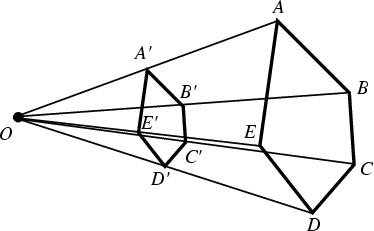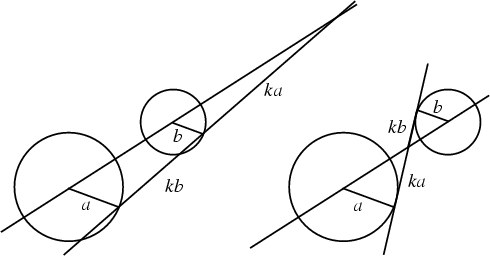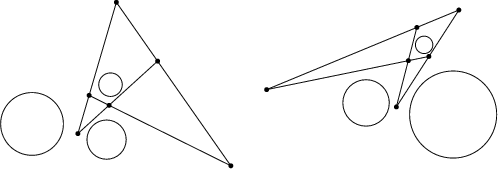|
|
|

The meeting point of lines that connect corresponding points from Homothetic figures. In the above figure, ![]() is
the homothetic center of the Homothetic figures
is
the homothetic center of the Homothetic figures ![]() and
and ![]() . For figures which are similar but do not
have Parallel sides, a Similitude Center exists (Johnson 1929, pp. 16-20).
. For figures which are similar but do not
have Parallel sides, a Similitude Center exists (Johnson 1929, pp. 16-20).

Given two nonconcentric Circles, draw Radii Parallel and in the same direction. Then the line joining the extremities of the Radii passes through a fixed point on the line of centers which divides that line externally in the ratio of Radii. This point is called the external homothetic center, or external center of similitude (Johnson 1929, pp. 19-20 and 41).
If Radii are drawn Parallel but instead in opposite directions, the extremities of the Radii pass through a fixed point on the line of centers which divides that line internally in the ratio of Radii (Johnson 1929, pp. 19-20 and 41). This point is called the internal homothetic center, or internal center of similitude (Johnson 1929, pp. 19-20 and 41).
The position of the homothetic centers for two circles of radii ![]() , centers
, centers ![]() , and segment angle
, and segment angle ![]() are given by solving the simultaneous equations
are given by solving the simultaneous equations
 |
As the above diagrams show, as the angles of the parallel segments are varied, the positions of the homothetic centers remain the same. This fact provides a (slotted) Linkage for converting circular motion with one radius to circular motion with another.

The six homothetic centers of three circles lie three by three on four lines (Johnson 1929, p. 120), which ``enclose'' the smallest circle.
The homothetic center of triangles is the Perspective Center of Homothetic Triangles. It is also called the Similitude Center (Johnson 1929, pp. 16-17).
See also Apollonius' Problem, Perspective, Similitude Center
References
Johnson, R. A. Modern Geometry: An Elementary Treatise on the Geometry of the Triangle and the Circle. Boston, MA:
Houghton Mifflin, 1929.
![]() Weisstein, E. W. ``Plane Geometry.'' Mathematica notebook PlaneGeometry.m.
Weisstein, E. W. ``Plane Geometry.'' Mathematica notebook PlaneGeometry.m.
|
|
|
© 1996-9 Eric W. Weisstein